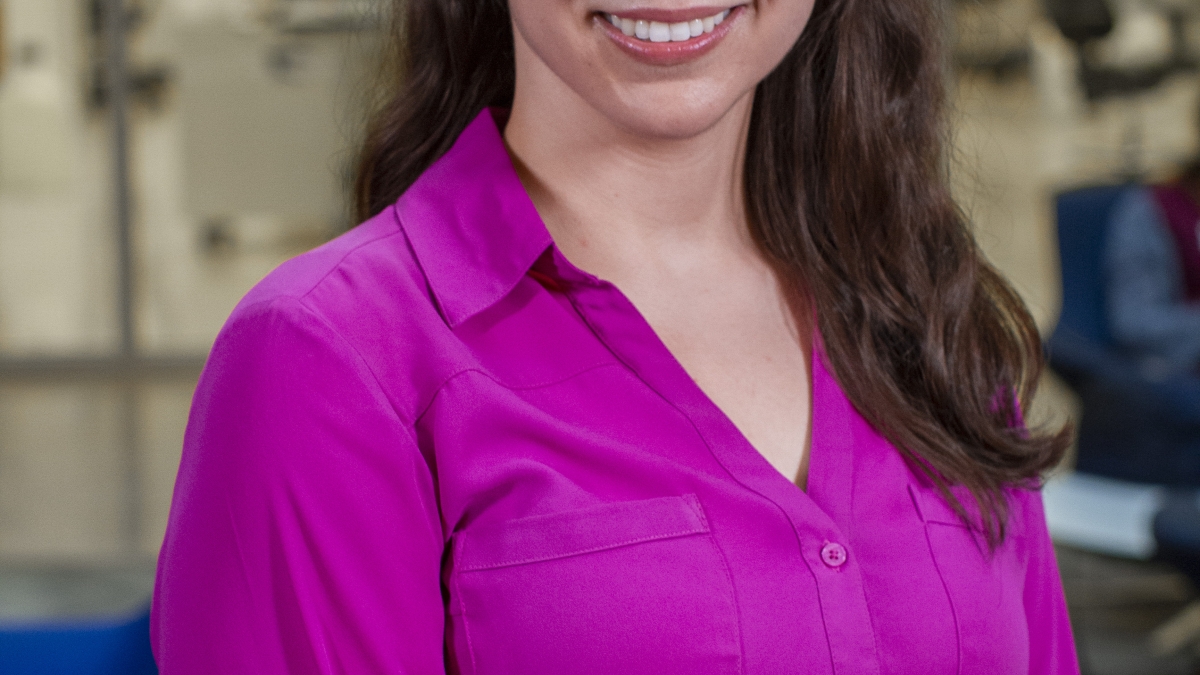Five years ago, Amanda Thart had no idea she’d be embarking on her career as an engineer in the defense industry.
The recent electrical engineering master’s degree graduate from the Ira A. Fulton Schools of Engineering at Arizona State University will begin a job as an electrical engineer at Raytheon Missile Systems in June.
When she began studies at ASU, Thart said, “I wanted to make an impact, but I had absolutely no idea how to go about it,” and the security field wasn’t even on her radar.
Her skills in math and science, and a special engineering program in high school called Project Lead the Way, led her to choose electrical engineering as a major. She found in ASU a college destination not too far away from her family but also a school that would give her the most opportunities, and she took full advantage of them.
“I was specifically drawn to ASU because there were a lot of extracurricular opportunities I wanted to get involved with, a lot of big companies were coming here looking for students and there are a lot of opportunities for undergraduate research,” she said. “I liked that."
Getting started in research early and jumping straight into to the ASU Grand Challenge Scholars Program opened door after door, especially in the security field, her chosen Grand Challenge theme.
Thart's first research project as a freshman was in Fulton Schools Assistant Professor Paulo Shakarian’s Cyber-Socio Intelligent Systems Lab. Her project involved looking at military events happening in Iraq and Syria and then identifying the causal relationship between them to predict what might happen next by using historical patterns and machine learning. The cross-disciplinary experience in Shakarian’s lab also gave her the first opportunity to be a co-author on peer-reviewed research journal articles.
“It was important for me to get involved in research that early, and Dr. Shakarian was willing to take me on even though I didn’t have any computer science experience,” Thart said. “My involvement (in Shakarian’s lab) opened the doors to so many things. I was not only able to get an introduction into computer science but I was also able to get an internship early.”
In addition to internships with Raytheon and Moog Broad Reach, Thart participated in the Engineering Projects in Community Service program, known as EPICS, at ASU and was a NASA Space Grant recipient. These experiences enabled her to apply her knowledge to hands-on engineering projects.
“Actually doing engineering and being in an engineering environment is different than learning things in class,” she said. “You’re never going to know what engineering is truly like until you take the knowledge you learn in class and apply it in a real-world setting.”
She also conducted research during her undergraduate years through the Fulton Undergraduate Research Initiative and for her thesis as an honors student in Barrett, The Honors College.
Thart joined the ASU chapter of the Society of Women Engineers and was a member of the STEM sorority Phi Sigma Rho and the electrical engineering and computer science honor society Eta Kappa Nu.
Her most memorable moment at ASU was presenting at the NASA Space Grant Symposium during her junior year. Though she had been involved in undergraduate research since her freshman year, this experience was the first time she had presented her research to a crowd instead of at a poster session.
“It was specifically that moment that was significant because it felt important that I was standing there, presenting research that was backed by an organization like NASA,” she said. “It was something I never expected to do when I came to college.”
Thart’s undergraduate experience culminated with a Moeur Award, the prestigious honor given to students who earn a 4.0 GPA for all classes taken at ASU. She was especially proud of this achievement because of how challenging her classes were and it meant she had successfully pushed through the ups and downs of her engineering degree.
But her educational journey wasn’t over yet. She immediately moved into the 4+1 accelerated master’s degree program in electrical engineering. Pursuing an advanced degree was an easy decision for Thart as she always knew she wanted one — to follow in the footsteps of her mom. This spring, Thart joined more than 930 Fulton Schools graduates who earned master’s degrees.
During both her undergraduate and graduate studies, mentors such as Robin Hammond, director of the Fulton Schools Career Center, and coworkers at her internships helped her figure out what she wanted to do in her career and how to get there.
Finding a role model in Laura McGill, vice president of engineering at Raytheon, helped Thart see how she could use her engineering skills and be a leader.
“I wanted to not only focus on a technical aspect of a problem, but the problem as a whole and have a higher-level view of engineering,” Thart said. “(McGill) showed me this role was possible.”
She also started to return the favor by getting involved during her junior year as an EPICS High mentor for high school students involved in community service engineering projects, and as an Engineering Futures mentor for first-generation college freshmen. The opportunities reminded her of her own experience in the Project Lead the Way program and motivated her to help aspiring engineers discover their love for the field.
“I realized I had all this knowledge I’d gained in college that I wanted to pass on to people because I wanted to make sure they had the best chance of success,” Thart said. “I can inform freshmen how to get to their goals and how to use the tools available to them.”
Thart’s idea of success in her engineering career is to one day have a position as an engineering leader like McGill and to keep learning more about different fields of engineering and business.
She also wants to continue mentoring at ASU, especially to encourage more diversity in the field and close the gender gap she noticed as an engineer herself.
“I want to make sure I continue working with students to not only show them what engineering is, but show everyone that it could be a viable option for them,” Thart said. “I want to open the doors to engineering for more people.”
More Science and technology

Compact X-ray laser lab aims to reveal deep secrets of life, matter and energy
X-rays allow us to view inside the human body to diagnose broken bones and other hidden problems. More recent X-ray advances are…

Apollo lunar samples enable ASU researcher to pinpoint moon’s crystallization timeline
A team of researchers, including Arizona State University geochemist Melanie Barboni, in collaboration with scientists from The…

NASA launches space telescope to chart the sky and millions of galaxies
California’s Vandenberg Space Force Base was the site for Tuesday’s 8:10 p.m. launch of the NASA SPHEREx mission aboard a SpaceX…


